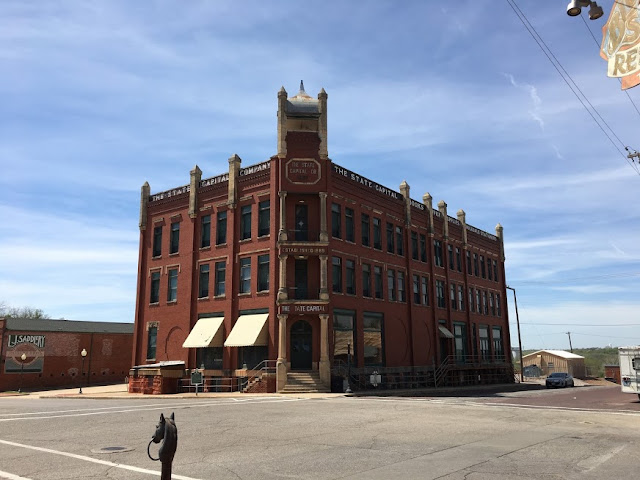In May 2016 daughter Becca and husband Matt Leon moved to Edmond, Oklahoma, so he could start his new faculty position at the University of Central Oklahoma. Dianne and I went along for the move, and as a result of that trip I posted a blog entry on Creek names that had followed Native Americans on the Trail of Tears from Alabama to Oklahoma.
Dianne and I recently made a trip through Edmond to Colorado Springs to visit her father. In this post and two more I'm sharing some of the photos I took in Oklahoma, Kansas and Colorado. Bear with me, and in the final post there are several Alabama-related payoffs!
I'm discussing these photos somewhat randomly, so here goes. Part 2 of this series can be found here.
One of the defining features of Colorado Springs is the view of Pikes Peak. Other features include the U.S. Air Force Academy and the large numbers of current and retired military personnel.
Although the town was founded in the late 19th century, most development seems to have taken place in the past three or four decades. The hills are crowded with vistas of new housing developments, and major roads are lined with commercial development---endless strip malls, mostly.
Fortunately, history and great natural beauty can be found there also. After a week or so, however, I start to miss all the southern greenery!
My mother-in-law and sister-in-law are both buried in Evergreen Cemetery in Colorado Springs, and we got to visit on this trip. A snow-covered Pikes Peak is in the background.
Here was pretty much our view coming and going across Kansas and eastern Colorado. Did you know that part of the country is very flat???
We had spotted this church on our way to Colorado Springs, and we stopped on the route home to take pictures. I believe it's in the small town of Simla, a bit over halfway between the Springs and I-70 on U.S. 24.
The wind farms were ubiquitous in Kansas and eastern Colorado. Some towers were close to I-70, others were far in the distance. We could not help thinking of the Martian invaders from H.G. Wells' War of the Worlds.
A common sight in Oklahoma are the "grasshoppers" or pumpjacks that draw oil from onshore wells with weak pressure. They are everywhere, including neighborhoods.
;
In Kansas we often saw these high-rises of the plains. We also passed several small towns with significant history. From I-70 you can see the twin spires of the Cathedral of the Plains in Victoria. When it was dedicated in 1911, Saint Fidelis Catholic Church was the largest church west of the Mississippi. We also passed the exit to Nicodemus, the only surviving western town founded by African-Americans after the Civil War.
Did I mention that we saw a lot of windmills? Now and then we also saw the much smaller wooden windmills on individual farms.
Now we come to some serious stuff. We arrived back in Edmond, Oklahoma, on the second Friday of our trip. The next day daughter Becca, son-in-law Matt, Dianne and I traveled a few miles to Guthrie, a town once the capitol of Oklahoma. The Guthrie Historic District contains over 2000 buildings, so there's a lot of history to see. One place is the Oklahoma Drug Store Museum, which is filled with fascinating things!
More about Guthrie in the final post in this series.













































